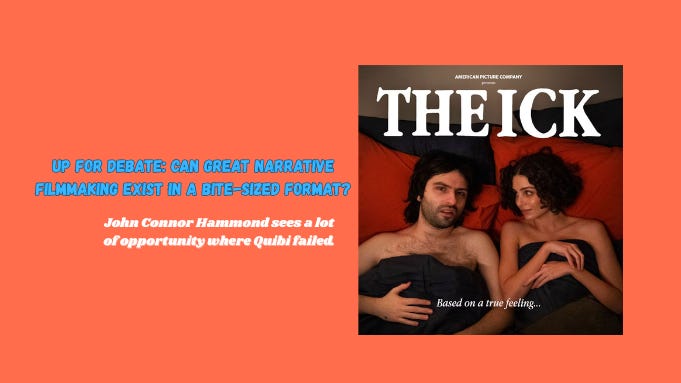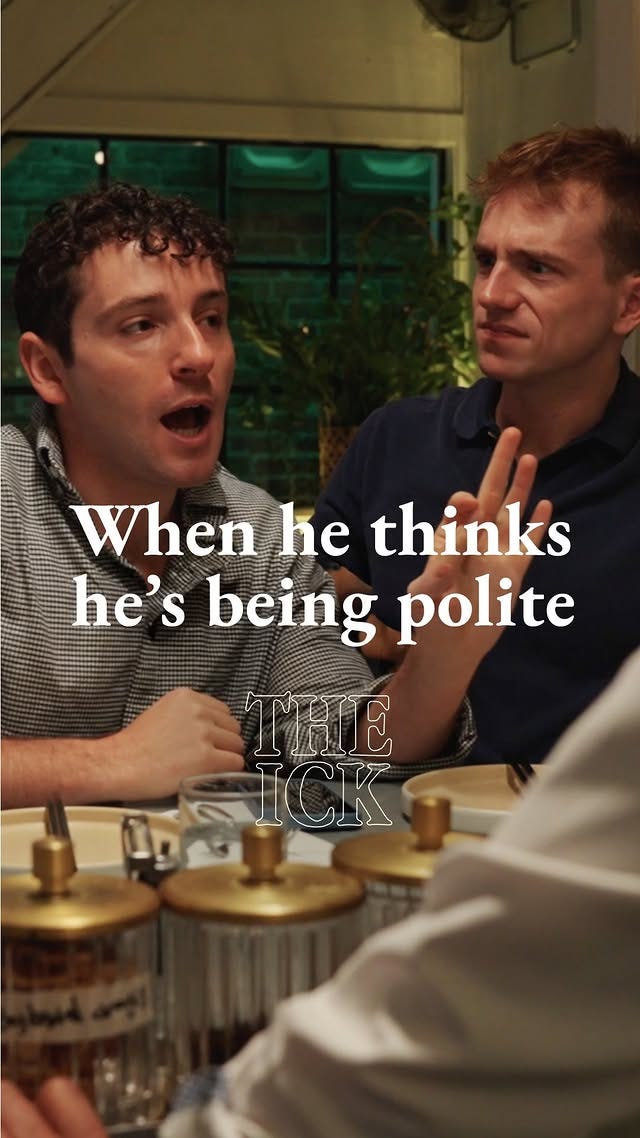Up For Debate: Did Quibi Have the Right Idea?
John Connor Hammond on the potential in bite-sized narrative filmmaking.
Up for Debate is a new series within Nothing Bogus where readers can make a case for, well… whatever they think would improve filmmaking, filmgoing, or the film landscape in some shape or form. Last week, Boni Mata argued for abolishing improv. Today, John Connor Hammond on why he thinks filmmakers should spend more energy on quality short-form storytelling. To pitch a column in this series, email nothingbogus1@gmail.com.
Open Instagram, TikTok, or YouTube, and odds are the first thing you’ll see is someone with a tiny mic asking a stranger, “How much do you pay for rent?” or “What are you listening to right now?”
The current content landscape is defined by cheaply made, unscripted shows that thrive simply because audiences are watching, in turn creating a self-fulfilling ecosystem of ad dollars fueling the continued production of these shows. We’re living in the era of the Man On The Street Show and as a filmmaker, this feels grim.
I myself am guilty of watching hours of this stuff a week - far more than I spend on movies or television. I don’t like this. But for me and for most people, it’s nothing new. Short-form is no longer an emerging format. It’s the dominant one.
Not coincidentally, filmmakers and cinephiles find themselves amidst an industry in upheaval. People don’t go to the movies like they used to and time watched on short-form platforms increases exponentially year over year - not to mention the looming threat of changes brought by AI. For filmmakers, this begs the question: Do I try to make films for an industry on the brink or do I let the tides pull me into the stream of content creation? The answer from most industry voices like agents, executives, and managers, is clear: “Pick up the tiny mic. Start your Man on the Street Show. Build your personal brand! Then maybe we’ll make your movie…”
But as a filmmaker committed to telling stories across a wide audience, I want to pose a different question: How can I make these platforms work for me? The answer to this question is what I’ve spent the past three years working toward in creating American Picture Company alongside my partner Ari Cagan, who is a certified short-form zealot. We envision a future where filmmakers can capture the powerful distribution tools of these platforms to tell great stories. Our mission was and continues to be elevating the short form into something not only watchable but meaningful.
At first, this endeavour caused industry peers to call us crazy, the most obvious reason for which being Quibi: Hollywood’s big swing at scripted short-form, which resulted in a $1.75 billion trainwreck. But now, after three years of creating, failing, learning and even succeeding, we see an exciting future for scripted short form storytelling, not just for our industry but for filmmakers everywhere.
This undertaking has obviously not been all sunshine and rainbows. Short-form is still a new narrative medium. There remains a ton of learning (and more importantly unlearning) that has to be done, starting with how we view our audience.
Audiences on short form platforms are often viewed as serial doom scrollers, wandering aimlessly through the algo like zombies in search of more brain-rot to feed on. However, I believe that doomscrolling is not a mindless pastime but an active and intentional search for something good to watch - something that strikes viewers in the same way a great movie or series does. Looked at from this perspective, there are major possibilities for accessing this medium’s potential.
In a social landscape flooded with snake oil salesmen touting “3 Easy Ways to go Viral on Tik Tok” and other hacks, it still feels challenging to find new ways of rising above the wave of disposable content. That’s why the fundamentals of filmmaking matter more than ever when it comes to short form. Instead of going down the road of Gary V, we should lean on the building blocks of proper storytelling: a sharp perspective, a rock solid script, compelling shot composition, world building mis-en-scene, etc. When your story is packaged in a 90 second vertical frame, watched by a viewer that holds the power in their thumb to swipe away at the first feeling of drag or boredom, the fundamentals of your filmmaking will be the differentiator between a viewer continuing to scroll or staying to watch.
The truth is that storytelling on short-form platforms offers us filmmakers an opportunity to reinvigorate and innovate the ways in which we tell stories. No longer confined to the restrictions of networks and programming blocks, our work can flourish in new and exciting ways. For example, in our series Cobell Energy, we experimented with using paratextual material as a complement to the show itself. We gave the company its own website where audiences could visit and apply for summer internships on oil rigs. We gave our characters their own Linkedin profiles and even released an audio recording where they get into a gunfight in a McDonald’s Drive Thru. Similarly, for our series The Ick, we source real audience submissions for episodes via a submission form, connecting us to our viewership in ways that were not previously possible. The comment sections of episodes have become public squares of dating debate.
As I attempt to rally other filmmakers to see the positives of short-form, there is often a negative response: short-form is just not as prestigious as the silver screen. I get it. A story playing out on a small vertical screen in the palm of your hand, in 30-90 seconds chunks, is just going to be a different experience.
But I’ve learned that this comparison can be limiting. In just 90 days of self-distributing The Ick, we’ve built an audience of over 140,000 followers and garnered 11 million views in the past 30 days alone. To put that into perspective: The hit network sitcom The Big Bang Theory averaged over 20 million viewers per week. But while each episode of The Big Bang Theory cost around $2.5 million to produce, we produced 15 episodes of The Ick for just $50,000. When you break that down by cost per viewer per minute, Big Bang comes in at roughly $0.006, while The Ick delivers at just $0.00015. We’re creating a new kind of series that is nearly 40 times more cost-efficient, while still delivering character, comedy, and connection at scale.
It’s in these short-form spaces, not in the movie theaters, where a bright new future of our industry lies. It’s a space that we hold more power than ever to usher in the next generation of great storytellers - so why not make short-form platforms our platforms?
Instead of perpetuating the Man on the Street Show, we hold an incredible opportunity to turn these spaces into something just like movie theaters, something that’s truly meaningful. Not a landfill of featuring more of the same slop, but a home for stories that resonate with us - just like cinema does.
The screens may be smaller, but the ambition and artistry don’t have to be. It’s time we stop treating short-form like a stepping stone and start treating it like the storytelling medium it already is.
John is the co-founder of American Picture Company, a studio, agency and production company making premium scripted series for the internet. Previously he founded the advertising agency Studio 181, and has produced, directed and wrote numerous award-winning films showcased at international festivals. He also co-created Cobell Energy, produced by Adam McKay, and has received multiple Vimeo Staff Picks and Webby nominations as a producer and director.
See also:
Jobs, programs, and other opportunities
The Listings
See You Soon is casting two roles — Kayla (18 - 25, Black, female, a late-night diner waitress whose quiet confidence and warmth makes people feel seen) and Trey (18 -25, Black, male, a familiar face from the neighborhood whose words hit harder than he realizes). Email seeyousooncasting@gmail.com by Friday Aug, 15. Must be based in LA. Paid. Include personal info, headshots, and acting reel.
Natalie Jasmine Harris is ISO a pitch deck designer who would be down to skill swap. For a horror film project. DM portfolio to @nataliejasmineharris.
Violette Trotter is seeking two roles for a Kelsea Bauman-Murphy and Audrey Rose Arnold-directed short. More here.
Adrian Anderson and Megan Bitchell are looking for a railroad style apartment, ideally with a door that leads directly into the living room (as opposed to a hallway) for a NYC shoot August 28-30. Will be paid! Email adrian@bohemian-man.com.
Art Craft NYC’s 2025 Portfolio Review will beAugust 14, 5 pm - 8 pm. The portfolio review is a great place to find your next Art, Set Dec, Props, or Graphics PA on a union job or Production Designer, Set Decorator, Art Director, etc etc for a low budget project. It will be at Feirstein Graduate School of Cinema, 6th Floor at Steiner Studios in the Navy Yard. 25 Washington Ave, Brooklyn, NY. RSVP is required for security purposes.
Alex Bliss is looking to rent an apartment in NYC for two weeks in September for a film he is making. Preferably empty or near empty. DM @albertblimp on IG.
Recently, I created this spreadsheet for producers to consult when seeking crew, gear, or scripts to develop. If you’re looking for work or to find collaborators, sign up. It’s free.
If you would like to list in a future issue, either A) post in the Nothing Bogus chat thread, or B) email nothingbogus1@gmail.com with the subject “Listing.” (It’s FREE!) Include your email and all relevant details (price, dates, etc.).








I agree that micro-series are a great opportunity for cost-effective filmmaking and the resurgence of the web series / Indie TV. Although I keep wondering if vertical formats on TikTok/Reels works BECAUSE they are lo-fi, and Quibi failed because it was too high-end, which might be better suited for other platforms? Even though it would be great if quality series gained more traction in the bite-sized vertical environment.
interesting stuff especially after reading the Indiewire article in June about Slamdance director Yun Xie moving into verticals work, but the key reason those platforms succeed is by using microtransactions to unlock serialized stories (not a dead-in-the-water subscription model like Quibi) — IG reels and TikTok will never produce any real ROI outside of partnerships/product placement